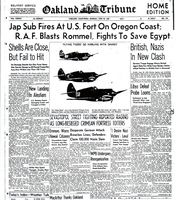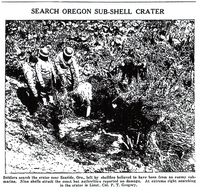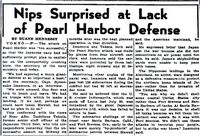
Attack on Oregon Coast by Japanese Submarine
June 21, 1942 a Japanese submarine surfaced off the coast of Oregon and fired up to 17 shots, none of which managed to do any kind of serious damage. The submarine was able to sail away unharmed as there was no return fire from Ft. Stevens where some coastal defense guns were present.

The I-25, the submarine responsible
 Oakland Tribune, June 22, 1942 |
 same source |
Front page headlines carried the news that the US coastland had been directly attacked by a Japanese submarine. The early report lists only nine shots as being fired, and that the submarine was probably, not positively, Japanese. It also notes that there was no actual damage anywhere, one reason very probably being that the attack took place near midnight, making aiming at targets rather difficult.
What is the natural reaction to such a thing? Look for souvenirs!
 The Lima News, June 23, 1942 |
 Syracuse Herald Journal, June 23, 1942 |
The article below (part of which was the photo above), gives a possible reason for the attack, and that was basically propaganda for the home front, and also to counter negative news (for the Japanese) of their losses at Midway.
Not only did the attack fail to cause any actual damage, but it also failed to really upset the civilian population, a typical comment being “some fireworks,eh?” It's one thing to hear bad news about things happening to “your side” when the events are far away; it's quite another when the events are literally on your doorstep, and in this aspect the Japanese attempt to panic the civilians failed all around. The submarine attacks failed to do it and the balloon bombs failed to do it.
It did, though, manage to stir up some Congressional tempers.
 The Sheboygan Press, July 22, 1942 |
This is a very interesting article. A republican senator from Oregon complained about the “criminally obsolete, woefully inadequate and poorly distributed” defense installations on the coast, pointing out that Fort Stevens had been attacked and its defense guns were from 1898 and there was no immediate airplane response to the shelling.
The point about the guns is significant since there is some argument about whether or not the submarine was actually in range of the guns or not. Whether it was or was not out of range is important since the fort did not return fire. One book that examines the issue, and has a lot of photos of the fort, is Panic at Fort Stevens from the Webb Research Group.
The book goes into the controversy and it makes quite interesting reading.
The next article is interesting in that it charges that somebody on shore had been signaling to the submarine.
 Walla Walla Union-bulletin, (WA), July 24, 1947 |
Note the article is two years after the war was over. It also goes into the decision not to return fire. Who did the alleged signaling is not answered, though.
 The Brainerd Daily Dispatch (MN) Sept. 8, 1945 |
 Indiana Evening Gazette, Sept. 8, 1945 |
The two articles are quite similar. The first says the attack on Fort Stevens and Santa Barbara were merely “by-products” of routine submarine patrols. The articles quote the Japanese source as saying that Fort Stevens and Santa Barbara were shelled due to oil tanks being present.
It seems that the Japanese seriously underused their submarine force, especially in relation to trying to stop shipping from the US west coast. It was also obvious from the attack on Fort Stevens that US coastal defenses were limited at best (the Fort Stevens guns were around 4,000 yards too short in range to hit the sub, at least according to some sources). It is fortunate for the US that matters turned out as they did and that the Japanese were never able to launch any kind of effective strike against the US mainland.
A sign posted in the area a few days after the attack.
Another sign in the area.
Main Index
Japan main page
Japanese-American Internment Camps index page
Japan and World War II index page
|